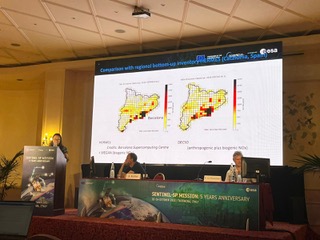
NOx and NH3 emissions derived from satellite observations

October 2022
Nitrogen emissions can be estimated using satellite observations and modelling
This data was presented by Jieying Ding at the Sentinel 5P 5-year anniversary
Nitrogen oxides (NOx) and Ammonia (NH3) emissions play an important role in air quality, the nitrogen cycle, and as precursors for climate gasses.
The most important sources of N emissions (NOx +NH3) are fossil fuel burning (industry and traffic) and agriculture (manure and fertiliser application). With the inversion algorithm DECSO (Daily Emissions Constrained by Satellite Observations), we derive quantitative NOx and NH3 emissions from TROPOMI (on Sentinel 5p) observations of NO2 and from CrIS (on SNPP) observations of NH3.
NOx emissions are derived on 5 to 20 km by taking advantage of the fine spatial resolution (5 x 3.5 km) of TROPOMI over different regions. Furthermore, the NOx emissions are split into 3 categories: fossil-fuel, soil and maritime emissions using detailed land use information and signatures of the seasonal cycle in the emissions. The intercomparison of DECSO with bottom-up inventories show good agreement for regional emission totals and its spatial distribution, but at a city-scale or focussing on individual sources (factories or power plants) interesting differences are found. For NH3, by considering the interaction between NH3 and NOx, we implement DECSO to estimate NOx and NH3 emissions simultaneously on 20 km resolution over European domain.

